Within the world of welding, two major techniques have appeared as go-to methods for joining metals: MIG welding and TIG welding. Both processes are widely used in various industries, each offering unique advantages and characteristics that cater to specific applications.
MIG welding, also known as Gas Metal Arc Welding (GMAW), and TIG welding, or Tungsten Inert Gas welding (GTAW), have distinctive features, making them useful for different welding scenarios.
In this article, we will dive into the differences between MIG and TIG welding, surveying their applications, techniques, and notable strengths, to help you understand which method may best fit your welding needs.
MIG Welding
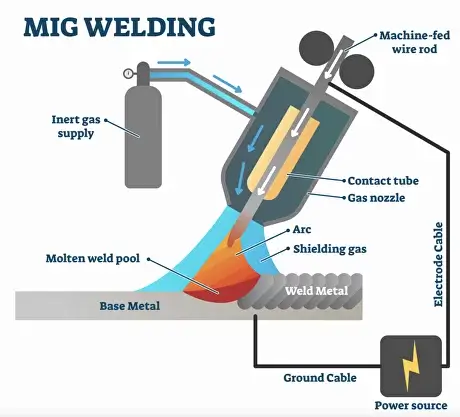
MIG welding, also known as Gas Metal Arc Welding (GMAW), is a welding procedure that uses a consumable electrode and a shielding gas to join metal pieces together. It is one of the most broadly used welding practices due to its flexibility and extent of use.
In MIG welding, a welding gun is used to sustain a continuous wire electrode (typically made of steel) into the weld joint. The electrode is consumed as it melts, creating a weld pool that fuses the base metals.
The welding gun also releases a shielding gas, such as argon or a mixture of argon and carbon dioxide, to protect the weld zone from atmospheric disgrace. The electrical current passes through the electrode, creating an arc that generates intense heat, melting the electrode and the base metals. The melted electrode material forms the filler metal that fills the joint and creates a strong bond when it solidifies.
MIG welding is known for its high welding speeds, as the continuous electrode feed allows for a rapid and uninterrupted welding process. It is commonly used in industries such as automotive, fabrication, construction, and manufacturing, for joining various metals like steel, stainless steel, and aluminum.
Advantages of MIG welding
MIG welding offers several advantages, including:
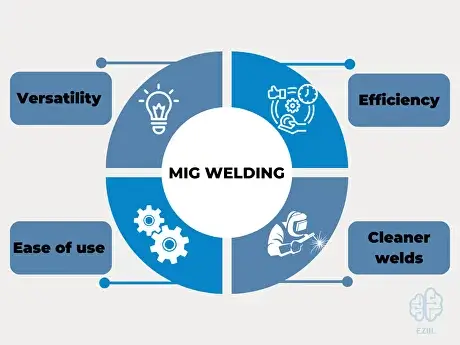
Versatility: It can be used to weld a wide range of metals and alloys.
Efficiency: The continuous wire feed and high welding speeds make it a fast process.
Ease of use: MIG welding is relatively easy to learn and operate, making it suitable for both beginners and experienced welders.
Cleaner welds: The shielding gas protects the weld pool from atmospheric contaminants, resulting in cleaner and more reliable welds.
However, MIG welding also has some limitations. It requires a constant shielding gas supply, making it less suitable for outdoor or windy conditions. Overall, MIG welding is a popular and versatile welding technique that offers speed, efficiency, and ease of use, making it widely used in various industries for joining metal components.
TIG Welding
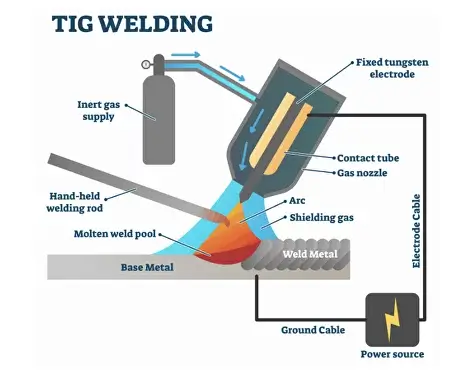
TIG welding, also known as Tungsten Inert Gas welding or GTAW (Gas Tungsten Arc Welding), is a precise and versatile welding process primarily used for welding thin sections of stainless steel, aluminum, and other non-ferrous metals. TIG Welding is renowned for producing high-quality welds with exceptional aesthetic appeal and strong mechanical properties.
In TIG welding, an electric arc is created between a non-consumable tungsten electrode and the workpiece. Unlike MIG welding, there is no consumable electrode in TIG welding. The tungsten electrode remains intact throughout the process and does not melt. The electrode is held in a TIG torch and an inert shielding gas, typically argon or helium, is continuously released to protect the welding zone from atmospheric contamination.
To ignite the arc, the welder touches the tungsten electrode against the workpiece and then quickly withdraws it while maintaining a suitable arc length. The heat generated by the arc causes the workpiece and any filler material (if used) to melt, forming a weld pool. If additional filler metal is required, it is manually fed into the weld pool.
Advantages of TIG Welding
TIG welding offers several advantages, including:
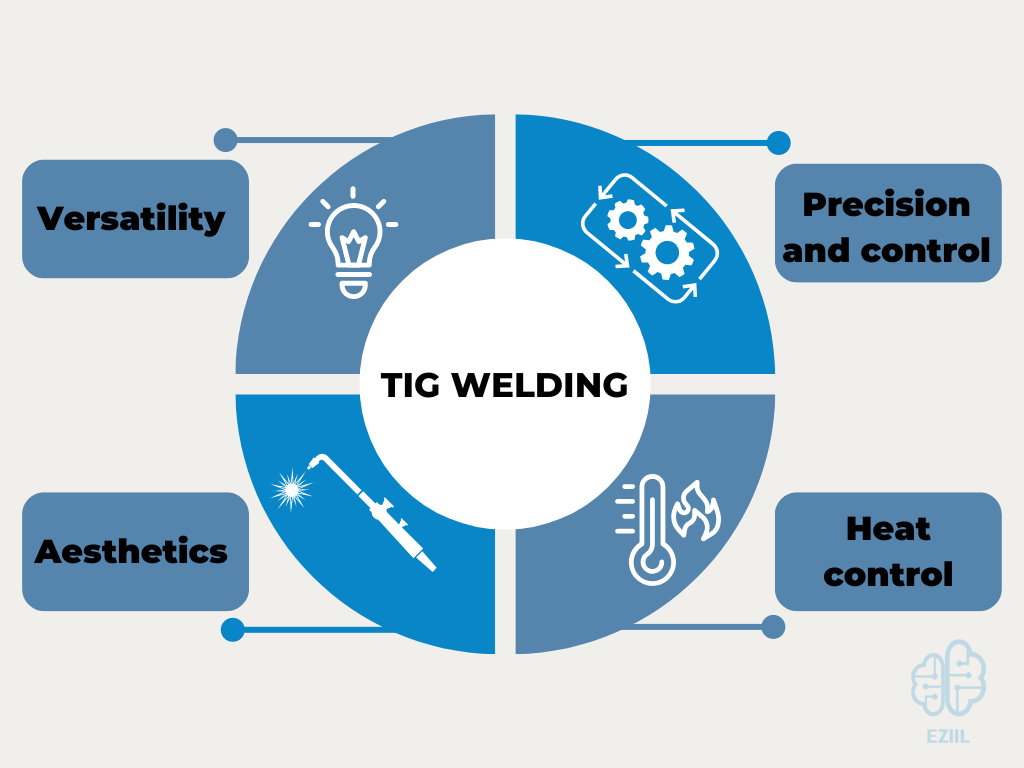
Precision and control: TIG welding allows precise control over the welding parameters, making it suitable for intricate welds, thin materials, and critical applications where accuracy is essential.
Aesthetics: TIG welds are known for their clean appearance with minimal spatter, creating smooth and visually appealing joints.
Versatility: TIG welding can be used on a wide range of metals, including stainless steel, aluminum, copper, titanium, and more.
Heat control: The heat input in TIG welding can be precisely regulated, reducing the risk of distortion or heat-affected zone (HAZ) issues.
However, TIG welding has some limitations. It is a relatively slow process compared to MIG welding, which can result in longer welding times and increased labor costs. Additionally, TIG welding requires a higher level of skill and expertise due to the need for manual control over various parameters, making it more challenging to learn and master.
Despite these limitations, TIG welding is often preferred in industries such as aerospace, automotive, and high-end fabrication, where the quality, precision, and aesthetic appeal of the welds are of utmost importance.
Some other Types of Welding Processes
Apart from MIG and TIG welding, there are numerous other welding processes (such as gas welding and tack welding) available that can be chosen according to the specific requirements of a project. One of these options is the Arc welding technique.

Arc Welding
ARC welding, also known as Shielded Metal Arc Welding (SMAW), (commonly called Stick Welding), is a widely used welding process that utilizes an electric arc between a flux-coated electrode and the workpiece to join metals together. It is a versatile and robust welding method that can be performed in various environments, including outdoor and windy conditions.
In ARC welding, the electrode, which consists of a solid metal core coated with a flux, is manually held in a welding holder or electrode holder. When the electrode comes into contact with the workpiece, an electric current is established, creating an arc. The intense heat generated by the arc melts the electrode and the base metal, forming a weld pool. As the weld pool cools, the electrode’s flux coating releases gas to shield the molten metal from atmospheric contamination.
It can be used to weld a wide range of metals, including carbon steel, stainless steel, cast iron, and some non-ferrous metals. It is commonly used in construction, fabrication, pipeline, and repair work, as well as in maintenance and emergency welding situations.
When we discuss the welding process or different welding types then it is also important to consider the skills and expertise of the person performing welding, who is often known as a Welder.
MIG vs TIG vs Arc Welding
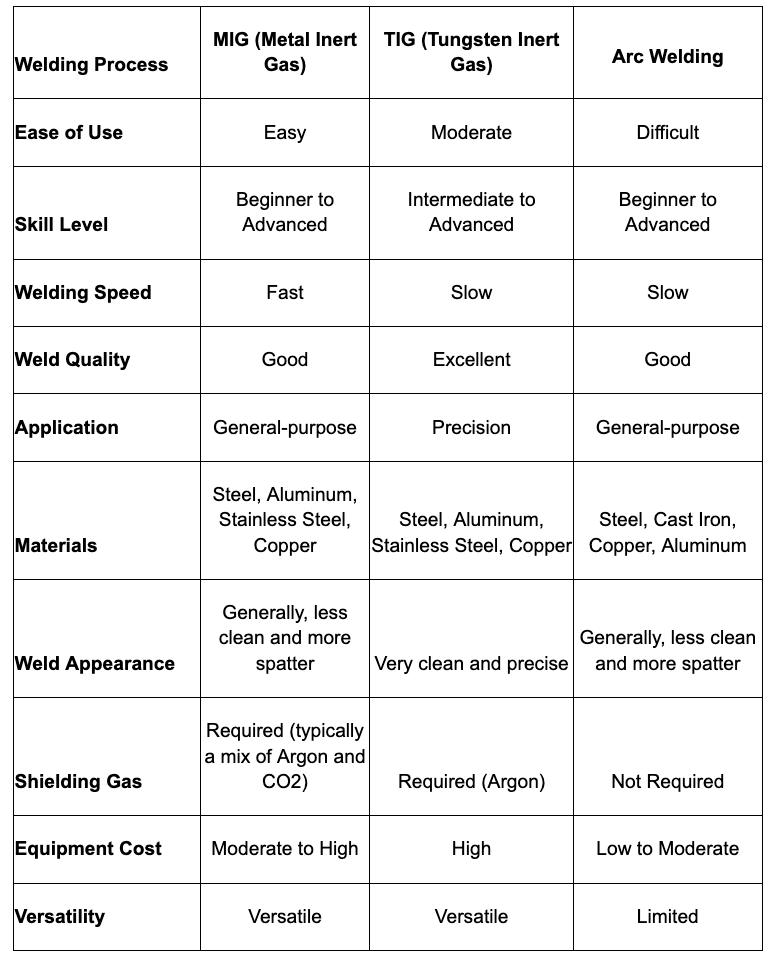
Welder
A welder is a skilled professional who specializes in the field of welding. Welders are trained and experienced in using various welding techniques to join metal pieces together. They work with a wide range of materials, such as steel, aluminum, and stainless steel, and employ different welding processes, including MIG, TIG, Stick, and more.
Welding aluminium presents its own unique set of challenges, but a skilled welder embraces these intricacies with mastery and precision. Aluminium, being a softer, highly conductive and reactive metal, requires a more refined touch and a good understanding of its properties. Whether the project involves building structures or manufacturing components, welding aluminium is an integral part of many welding tasks.
Welders need to have a strong understanding of metallurgy, welding principles, and safety procedures. They must be skilled in interpreting technical drawings and possess good hand-eye coordination, attention to detail, and problem-solving abilities. Welders often undergo formal training or apprenticeships to acquire the necessary knowledge and skills, and some may pursue professional certifications to demonstrate their expertise.
Mig Welder and Tig Welder
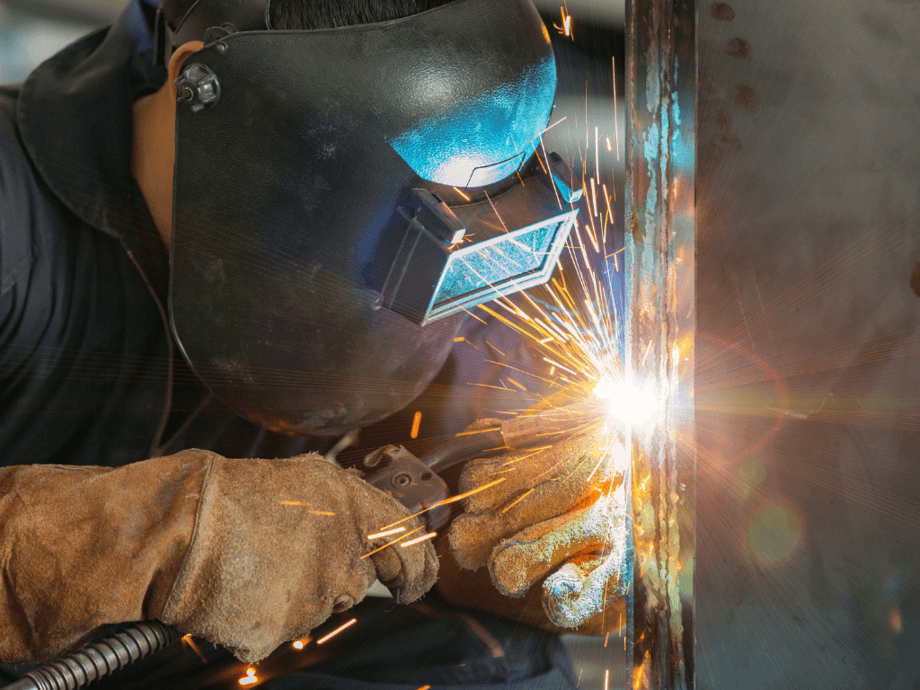
The primary task of a Mig welder and Tig welder is to operate welding equipment and tools to perform the joining process. They work with different types of welding techniques, such as MIG (Metal Inert Gas), TIG (Tungsten Inert Gas), arc welding, and oxy-acetylene welding.
Depending on the project requirements and materials involved, MIG and TIG welders select the appropriate welding method, determine the correct parameters (like current, voltage, and gas flow), and prepare the workpieces accordingly.
MIG welders and TIG welders work with a variety of metals, including steel, aluminum, stainless steel, and other alloys.
They are responsible for interpreting blueprints, drawings, or specifications to understand the required weld joints, dimensions, and tolerances. They then set up the welding equipment, prepare the surfaces by cleaning or removing contaminants, and position the parts to be welded in the correct alignment.
Working with welding machines forms an essential part of a MIG or TIG welder’s day-to-day role. Welding machines, designed with versatility and precision in mind, are indispensable when it comes to shaping and uniting metal parts. They ensure that every weld is executed with precision and quality.
Whether it’s MIG or TIG welding, the machine’s capability can dramatically impact the outcome. It’s not only about how the welder maneuvers, but also about how well the welding machine performs to deliver desired results.
That’s why investing in top-notch welding machines is a priority for professionals in this field, recognizing that a good welding machine makes a world of difference in the final product.
Conclusion
This comprehensive article highlights the three primary welding techniques widely employed in the industry for projects ranging from small to large in size. These techniques include MIG (Metal Inert Gas) Welding, TIG (Tungsten Inert Gas) Welding, and Arc welding (or Stick Welding). Each technique possesses distinct advantages and disadvantages.
The main difference between these welding processes is the type of electrode, the shape of the electrode, and the method used to avoid oxidation of the molten metal. For example, MIG and Arc welding uses a consumable electrode while TIG welding uses a non-consumable electrode with a separate filler metal. Similarly, the electrode used in Arc Welding has a coating layer that minimizes the oxidation of molten metal while MIG and TIG welding use a shield of inert gas for the same purpose.
As well as the practical aspects of these welding techniques are concerned, MIG welding is known for its high productivity and suitability for thicker materials, making it commonly employed in manufacturing and construction industries. On the other hand, TIG welding is favored for its ability to produce precise and high-quality welds, making it suitable for thin materials or projects that require exceptional aesthetic appeal and structural integrity.